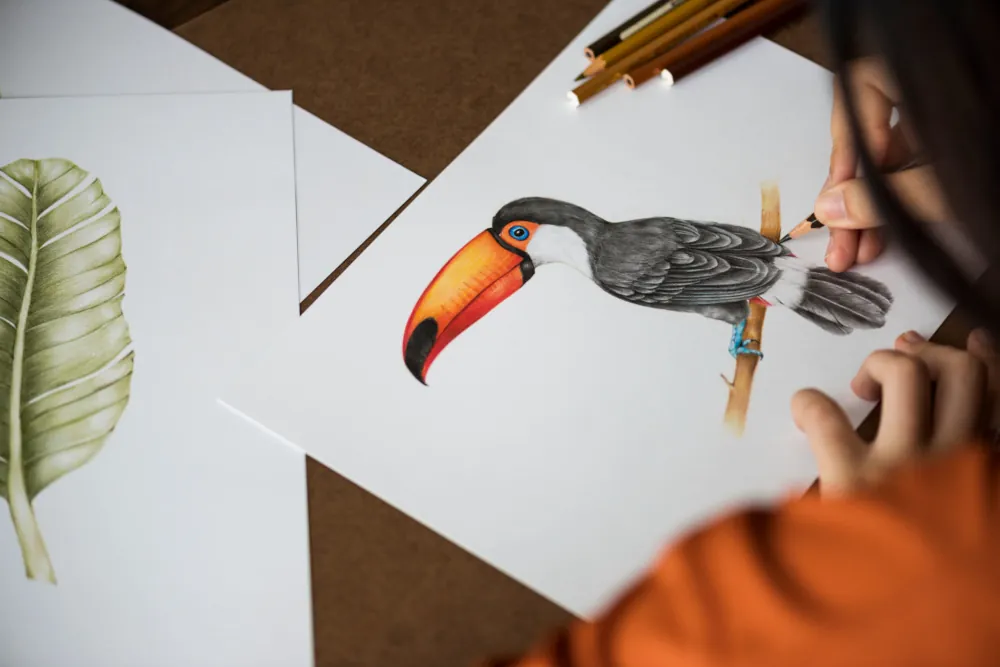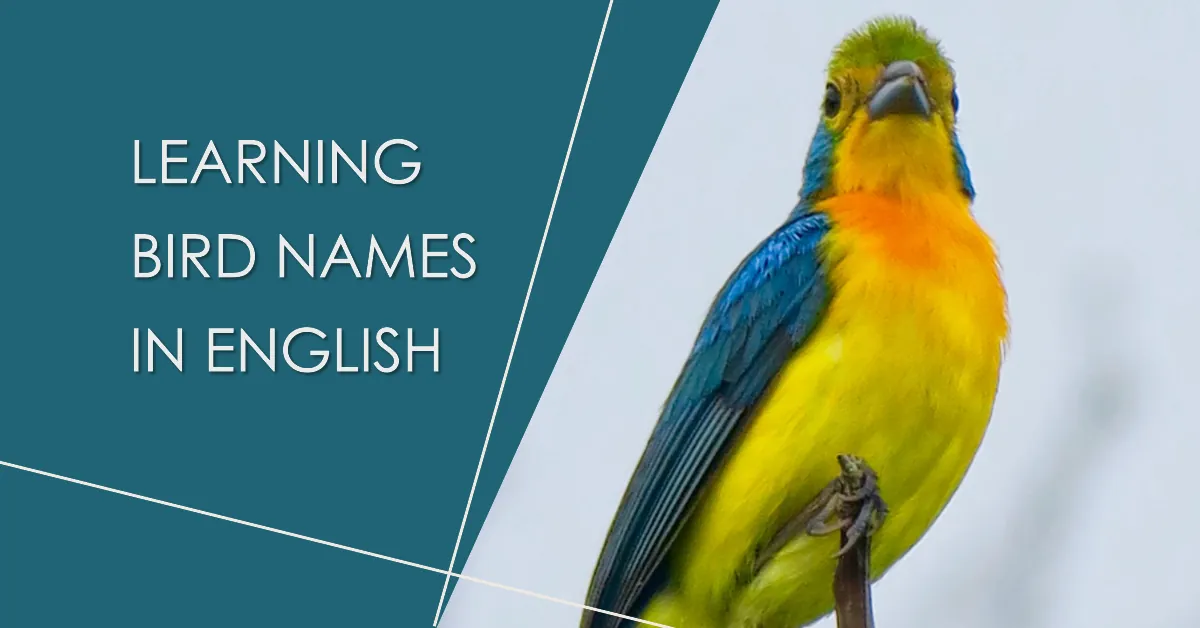Birds are some of the most diverse and fascinating animals on Earth, with over 10,000 species found in every corner of the globe.
Knowing their English names is important for several reasons.
First, it allows us to communicate about birds with others, whether we are talking to a friend, a fellow birdwatcher, or a scientist. Second, knowing bird names can help us learn more about them by looking up information about their habits, diet, and habitat. Finally, knowing bird names can simply be fun, as many birds have interesting and unique names.
In this article, we will explore the world of birds with names in English. We will provide a list of common English names of birds, discuss different methods for learning bird names, and introduce a glossary of common English language terms used in the description of birds.
We hope that this article will help you to learn more about birds and their names in English.
I. Common English names of birds
The following is a list of common birds with names in English:
| No. | Common Bird Names |
|---|---|
| 1. | Sparrow |
| 2. | Robin |
| 3. | Eagle |
| 4. | Hawk |
| 5. | Crow |
| 6. | Pigeon |
| 7. | Blue Jay |
| 8. | Cardinal |
| 9. | Finch |
| 10. | Pelican |
| 11. | Seagull |
| 12. | Owl |
| 13. | Hummingbird |
| 14. | Woodpecker |
| 15. | Duck |
| 16. | Goose |
| 17. | Swallow |
| 18. | Kingfisher |
| 19. | Falcon |
| 20. | Parrot |
| 21 | Quail |
| 22 | Swan |
| 23 | Turkey |
The above list is just a small sample of the many common English names of birds. There are many other species of birds that could be included, but these are some of the most well-known and familiar.
II. Learning Bird Names in English

There are many different ways to learn bird names in English. Here are a few ideas:
- Draw birds. Drawing birds is a great way to learn about their physical features and to memorize their names. You can find many bird coloring books and drawing tutorials online and in libraries.
- Write about birds. Creative writing is another great way to learn bird names. You can write poems, stories, or essays about birds. You can also try writing bird field notes, which are brief descriptions of the birds you see in the wild.
- Use mnemonic devices. Mnemonic devices are memory aids that can help you to remember bird names. For example, you might use the following mnemonic device to remember the names of three common owl species: “Barn owls say whoo, great horned owls say hoo, hoo, hoo, and northern saw-whet owls say too-too.”
- Play bird-related games. There are many different bird-related games that can help you to learn bird names. For example, you can play bird bingo, bird trivia, or bird matching games. You can also find many bird-related games online and in app stores.
Taking the time to learn about bird names isn’t just educational; it’s an experience that can add a whole new dimension to your appreciation for the beauty of the natural world.
III. Glossary of bird terms
Here is a glossary of common English language terms used in the description of birds:
| Number | Term | Description |
|---|---|---|
| 1 | Beak | The hard, horny bill of a bird. |
| 2 | Bristle | A stiff, hair-like feather. |
| 3 | Call | A vocal sound made by a bird. |
| 4 | Crest | A plume of feathers on the head of a bird. |
| 5 | Crown | The top of a bird’s head. |
| 6 | Eye ring | A ring of colored feathers around a bird’s eye. |
| 7 | Flight feather | A long, narrow feather that helps a bird to fly. |
| 8 | Hackles | Feathers on the neck and back of a bird. |
| 9 | Hindclaw | The long, sharp claw on the back toe of a bird. |
| 10 | Iris | The colored part of a bird’s eye. |
| 11 | Keel | A bony ridge on the underside of a bird’s sternum that helps to support the muscles used for flying. |
| 12 | Lores | The feathers between a bird’s eye and bill. |
| 13 | Mantle | The feathers on the back of a bird between the shoulders and the tail. |
| 14 | Nape | The back of a bird’s neck. |
| 15 | Primary flight feathers | The ten flight feathers on the leading edge of a bird’s wing. |
| 16 | Rump | The base of a bird’s tail. |
| 17 | Secondary flight feathers | The six to twelve flight feathers on the trailing edge of a bird’s wing. |
| 18 | Tail coverts | The feathers that cover the base of a bird’s tail. |
| 19 | Tarsi | The long, slender bones in a bird’s lower leg. |
| 20 | Tertial flight feathers | The six to twelve flight feathers on the inner edge of a bird’s wing. |
| 21 | Throat | The front of a bird’s neck. |
| 22 | Univocal | A type of bird song that is made up of a single note or phrase. |
Also Read: 15 Idioms and Expressions Related to Students
IV. Conclusion
Learning the names of birds in English is an important step in understanding and appreciating these amazing creatures. By knowing the names of birds, we can better communicate about them with others, learn more about them, and appreciate their role in the environment.
There are many different ways to learn bird names in English. Drawing birds, writing about birds, using mnemonic devices, and playing bird-related games are all effective ways to learn bird names. There are also many resources available to help you learn bird names, such as bird field guides, bird identification apps, and bird games.
Learning bird names in English can be a challenging but rewarding experience. By taking the time to learn bird names, you can better appreciate the beauty and diversity of these amazing creatures.
Frequently Asked Questions (FAQs)
Here are 10 bird names in simple and easy terms: Robin, Blue jay, Crow, Dove, Sparrow, Eagle, Owl, Hawk, Duck and Swan
One bird that is found exclusively in India is the Indian Peafowl, also known as the Indian Peacock (scientifically named Pavo cristatus).
The Indian Peacock is the national bird of India and is culturally significant, often associated with beauty and grace in various traditions and mythology.
Vulture
The smallest bird in India is the Flowerpecker (Dicaeum erythrorhynchos). It is a tiny bird, only about 8-10 cm long, with a wingspan of 14-16 cm. It has a short, slender beak and a long tail. The male flowerpecker is brightly colored, with a green back and head, a yellow chest, and a red rump. The female flowerpecker is duller in color, with a brown back and head and a yellow chest.
The Great Indian Bustard is the largest bird in India. It is a ground bird that can grow up to 1 meter tall and weigh up to 15 kg. It is one of the largest and heaviest flying birds.
The Great Indian Bustard is found in dry grasslands and scrublands in India. It was once found throughout the Indian subcontinent, but is now only limited to the states of Gujarat and Rajasthan.

